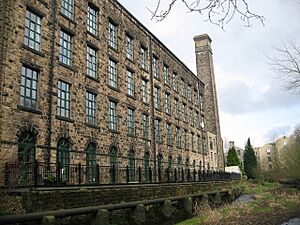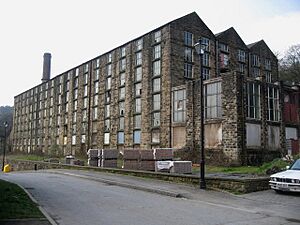List of mills in Saddleworth facts for kids
Saddleworth is a lovely area in Greater Manchester, England. It's made up of several villages and small communities nestled among the Pennine hills. Places like Uppermill, Greenfield, Dobcross, Delph, and Diggle are all part of Saddleworth. For a long time, Saddleworth was famous for making woollen cloth.
Later, during the time of the Industrial Revolution, Saddleworth became a big centre for making cotton. This meant building many large factories called textile mills. These mills were places where raw cotton was spun into thread and then woven into fabric. This article will tell you about some of the important mills that once stood, or still stand, in Saddleworth.
Contents
What are Textile Mills?
Textile mills are like big factories where cloth is made. In the past, people used to make cloth by hand in their homes. This was called the "domestic system." But with new inventions, machines were created that could spin thread and weave fabric much faster.
These machines needed a lot of power, first from water wheels and later from steam engines. So, large buildings, or mills, were built to house them. These mills changed how people worked and lived, bringing many jobs to areas like Saddleworth.
Saddleworth: A Hub for Mills
Saddleworth was a great place for mills because it had rivers for water power and was close to places where cotton arrived. For centuries, people in Saddleworth were skilled at making woollen cloth. When cotton became popular, they adapted quickly.
Many mills popped up across the villages, changing the landscape. These mills provided work for many people, including children and adults. They helped Saddleworth grow and become an important part of the textile industry in England.
Famous Mills of Saddleworth
Many mills operated in Saddleworth, each with its own story. Some have been changed into new buildings, while others are no longer standing. Here are a few examples:
Alexandra Mill: From Cloth to Homes
Alexandra Mill in Uppermill was built in 1860. It was first used by a company that made flannel, a type of soft woollen fabric. This mill is made of stone and has four floors. Over the years, it had many different uses.
In the 1980s, it became a craft centre with many small shops. Today, Alexandra Mill has been beautifully changed into modern apartments. It sits right by the River Tame, showing how old buildings can find new life.
Bailey Mill: A Story of Change
Bailey Mill in Delph was a busy place for many years. It finally closed down in 1996. After it closed, the mill building stayed empty for a long time. Its future was uncertain.
An old railway line, known as "The Delph Donkey," used to run right in front of the mill. This railway line is now a popular walking and cycling path. Sadly, in 2016, Bailey Mill was badly damaged by a fire and collapsed.
Victoria Mill: Now a Museum!
Victoria Mill in Uppermill has a very special story. While the main mill building was demolished, one of its smaller buildings still stands. This remaining building is now home to the Saddleworth Museum and Art Gallery.
The museum is a fantastic place to learn about the history of Saddleworth, including its textile mills. It's a great example of how old industrial sites can be used to teach us about the past.
Other Notable Mills
- Albion Mill: Also in Uppermill, this mill was built around 1854. It has also been converted into apartments, just like Alexandra Mill.
- Bentfield Mill: Located in Greenfield, this mill started as a woollen mill around 1790. It was rebuilt as a cotton mill in 1868 before going back to wool. The area where it stood is now covered by houses.
- Brookside Mill: In Grotton, part of this mill was taken down in 1930. Interestingly, its mill pond was used as a swimming pool for a while! The site is now housing.
- Oak View Mill: This mill is in Greenfield.
- Shore Mill: Found in Delph, this was a water-powered woollen mill from the 1780s. It's now homes, but you can still see parts of the old water wheel system.
Life in a Mill Town
The mills brought many changes to Saddleworth. More people moved to the area for work, and new houses were built. The sound of the mill machinery would have been a constant part of daily life. While the work was often hard, the mills also created communities and helped the area grow.
Today, many of the old mills have found new purposes, like homes or museums. They stand as reminders of Saddleworth's rich industrial past and the hard work of the people who lived and worked there.
Images for kids




